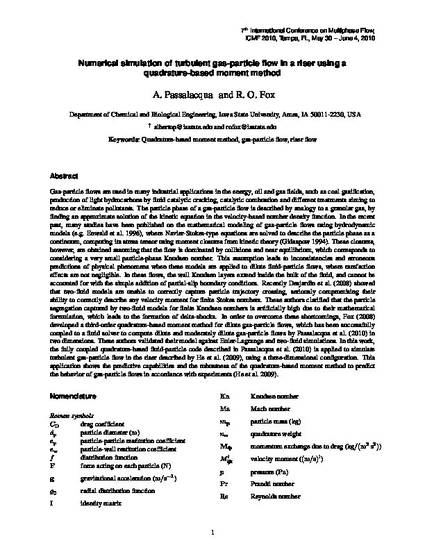
Presentation
Numerical simulation of turbulent gas-particle flow in a riser using a quadrature-based moment method
Chemical and Biological Engineering Conference Presentations and Proceedings
Document Type
Conference Proceeding
Disciplines
Conference
7th International Conference on Multiphase Flow, ICMF 2010
Publication Date
1-1-2010
Geolocation
(27.950575, -82.45717760000002)
Abstract
Gas-particle flows are used in many industrial applications in the energy, oil and gas fields, such as coal gasification, production of light hydrocarbons by fluid catalytic cracking, catalytic combustion and different treatments aiming to reduce or eliminate pollutants. The particle phase of a gas-particle flow is described by analogy to a granular gas, by finding an approximate solution of the kinetic equation in the velocity-based number density function. In the recent past, many studies have been published on the mathematical modeling of gas-particle flows using hydrodynamic models (e.g. Enwald et al. 1996), where Navier-Stokes-type equations are solved to describe the particle phase as a continuum, computing its stress tensor using moment closures from kinetic theory (Gidaspow 1994). These closures, however, are obtained assuming that the flow is dominated by collisions and near equilibrium, which corresponds to considering a very small particle-phase Knudsen number. This assumption leads to inconsistencies and erroneous predictions of physical phenomena when these models are applied to dilute fluid-particle flows, where rarefaction effects are not negligible. In these flows, the wall Knudsen layers extend inside the bulk of the fluid, and cannot be accounted for with the simple addition of partial-slip boundary conditions. Recently Desjardin et al. (2008) showed that two-fluid models are unable to correctly capture particle trajectory crossing, seriously compromising their ability to correctly describe any velocity moment for finite Stokes numbers. These authors clarified that the particle segregation captured by two-fluid models for finite Knudsen numbers is artificially high due to their mathematical formulation, which leads to the formation of delta-shocks. In order to overcome these shortcomings, Fox (2008) developed a third-order quadrature-based moment method for dilute gas-particle flows, which has been successfully coupled to a fluid solver to compute dilute and moderately dilute gas-particle flows by Passalacqua et al. (2010) in two dimensions. These authors validated their model against Euler-Lagrange and two-fluid simulations. In this work, the fully coupled quadrature-based fluid-particle code described in Passalacqua et al. (2010) is applied to simulate turbulent gas-particle flow in the riser described by He et al. (2009), using a three-dimensional configuration. This application shows the predictive capabilities and the robustness of the quadrature-based moment method to predict the behavior of gas-particle flows in accordance with experiments (He et al. 2009).
Language
en
Citation Information
Alberto Passalacqua and Rodney O. Fox. "Numerical simulation of turbulent gas-particle flow in a riser using a quadrature-based moment method" Tampa, FL(2010) Available at: http://works.bepress.com/rodney_fox/50/

This article is from 7th International Conference on Multiphase Flow, ICMF 2010, Tampa, FL, May 30-June 4, 2010. p. 1-8.